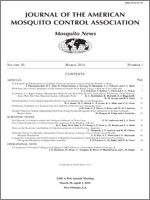Four commercially available spatial repellent devices were tested in a rice-land habitat near Stuttgart, AR, after semi–field level assessments had been made at the Center for Medical, Agricultural, and Veterinary Entomology, Agricultural Research Service, US Department of Agriculture in Gainesville, FL. OFF! Clip-On® (metofluthrin), Mosquito Cognito® (linalool), No-Pest Strip® (dichlorvos), and ThermaCELL® (d-cis/trans allethrin) were selected for this study from >20 candidate products. The units based on metofluthrin, linalool, or d-cis/trans allethrin significantly reduced captures of 1 or more of the mosquito species at surrogate human sites (unlit Centers for Disease Control and Prevention traps with CO2 and octenol). Among the mosquito species analyzed statistically (Anopheles quadrimaculatus, Culex erraticus, and Psorophora columbiae), there were significantly different responses (up to 84% reduction) to individual products, suggesting that combinations of certain spatial repellents might provide significantly greater protection.
How to translate text using browser tools
1 March 2014
Field Evaluation of Four Spatial Repellent Devices Against Arkansas Rice-Land Mosquitoes
David A. Dame,
Max V. Meisch,
Carolyn N. Lewis,
Daniel L. Kline,
Gary G. Clark
ACCESS THE FULL ARTICLE
It is not available for individual sale.
This article is only available to subscribers.
It is not available for individual sale.
It is not available for individual sale.
Anopheles quadrimaculatus
CO2
Culex erraticus
octenol
Psorophora columbiae
surrogate human





